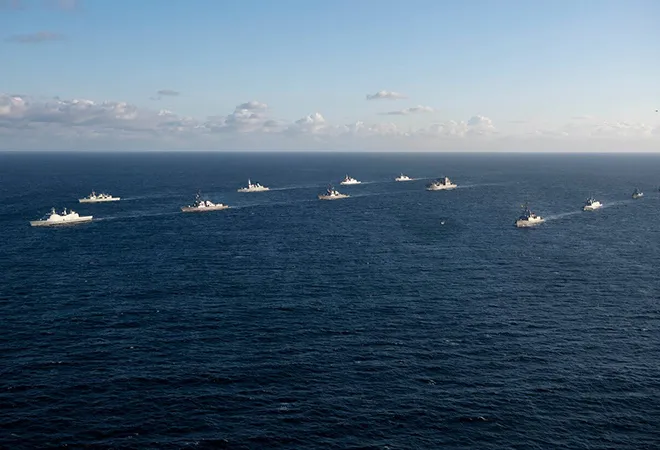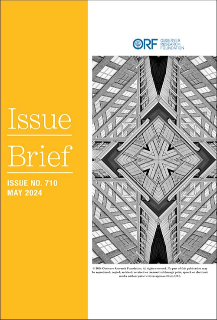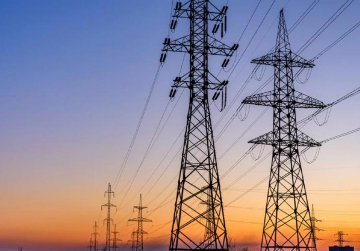
The 2021 edition of the Cutlass Express, which is a U.S. Africa Command-(USAFRICOM) directed annual multinational maritime exercise conducted by U.S. Naval Forces Africa to promote national and regional maritime security in East Africa and the Western Indian Ocean (WIO). This year, it commenced on 26 July in the vicinity of Djibouti, Kenya, Madagascar, and the Seychelles. The drills, which would go on till 6 August 2021, are designed to assess and improve regional cooperation in support of the Djibouti Code of Conduct (DCoC), create maritime domain awareness (MDA), and facilitate information sharing between maritime operations centres.
This year’s edition involves the participation of 12 East African countries, the UK, India, and various international organisations such as the International Maritime Organisation (IMO), United Nations Office on Drugs and Crime (UNODC), European Union Naval Force Somalia (EUNAVFOR), Critical Maritime Routes Indian Ocean (CRIMARIO), EUCAP Somalia, and Interpol. The Indian Navy’s guided missile frigate INS Talwar is participating in the exercise, where it is undertaking the training of contingents from participating countries in various fields across the spectrum of maritime security operations.
Most of the African countries participating in this exercise do not have sufficient naval capabilities or coastal security force to effectively patrol their waters and counter illicit maritime activity. Therefore, the training of naval personnel and the valuable operational experience gained under such multilateral exercise, like the Cutlass Express, is vital for improving interoperability and developing shared operating procedures between the participating navies. The broader aim is to improve African states’ ability to suppress and counter illegal activities, including piracy, arms and drugs trafficking, human smuggling, and illegal trade in wildlife.
The training of naval personnel and the valuable operational experience gained under such multilateral exercise, like the Cutlass Express, is vital for improving interoperability and developing shared operating procedures between the participating navies.
India’s participation in the Cutlass Exercise is taking place right on the heels of the External Affairs Minister Dr. S Jaishankar’s recent visit to Kenya and U.S. Secretary of State Antony Blinken’s visit to New Delhi. Secretary Blinken’s visit to India revealed both convergences and divergences in the Indo-U.S. partnership. While the India and U.S. relations have grown in recent years, mostly due to bilateral and multilateral cooperation on Indo-Pacific and the Quadrilateral Security Dialogue (Quad), some challenges have also come to the forefront. India is concerned about the possibility of Afghanistan turning into a safe haven for extremists, post American withdrawal from the war-torn nation. Concerns over getting access to raw materials for the production of COVID-19 vaccines, and democracy and human rights are some of the other issues. Despite these challenges, New Delhi and Washington are keen to expand their cooperation in issues ranging from infrastructure development, climate change, and maritime security.
Indian concerns and standing on the Indo-Pacific
Although the Indian Navy is increasingly being recognised as a ‘preferred security partner’ in the Indian Ocean Region (IOR), it is important to realise that no power, including India, can unilaterally match up with Chinese military capabilities and economic heft. This provides rationale for ‘similar thinking’ countries like India and the U.S., which share similar values, ideals, and democratic tradition, to work together in order to ensure a transparent and rules-based maritime order in the Indo-Pacific. Concerns over a rising China, and its growing belligerence in the Indo-Pacific has been a key factor which has led to strengthening of Indo-U.S. defence and security ties in recent years.
On its part, the Biden administration has certainly been keen to institutionalise the Indo-Pacific and formalise the Quad, in order to balance China. However, as emphasised by PM Modi in his address at Shangri La Dialogue in 2018, India does not consider the Indo-Pacific region as a club or grouping of limited members that seeks to dominate and is directed against any specific country. As some observers have argued, India in its Indo-Pacific strategy, has so far adopted a conciliatory approach rather than a confrontationist one.
India’s emphasis has mostly been on finding mutual avenues of cooperation and evolving a normative framework of tackling not only deterrence or hard security aspects, but also non-traditional security challenges like environmental security, IUU fishing, HADR, arms, drugs and human smuggling, blue economy, tourism, etc. These issues have a direct bearing on the economic well-being and sustainable development of East African and Indian Ocean island nations. Therefore, it is incumbent on India, U.S., or other external powers to factor in these considerations while developing their strategies for maritime security engagement with African countries.
The African perspective
For some time now, external powers have been scrambling to set up naval and military bases in Africa. In this process, these countries are attempting to align with friendly regimes for protecting their investments and safeguarding the commercial sea lanes from piracy. As a result, African leaders have continuously voiced their apprehensions about getting caught in between great power contestation. Without clearly defining their national interests, power capabilities, and taking direct policy positions on the Indo-Pacific, African countries risk getting marginalised from the very process and activities that will impact the continent’s long-term prosperity and interests. As such, it is increasingly becoming difficult for African states to remain passive bystanders and adopt a position of neutrality.
China remains a pivotal actor in the geo-economic realm and preferred partner of many African countries for the funding of critical infrastructure.
Though perceptions from country to country may vary, Africans generally welcome Chinese commercial engagement in the continent. China remains a pivotal actor in the geo-economic realm and preferred partner of many African countries for the funding of critical infrastructure. Chinese enterprises have invested billions of dollars towards African infrastructure development projects, especially since the inception of Chinese Belt and Road Initiative (BRI). A case in point was the recent construction of Lamu port in Northern Kenya. China has also recently resumed talks with new Tanzanian President Samia Suluhu Hassan’s administration to revive the US $10 billion Bagamoyo port project. Although such projects might be perceived as threatening to Indian and U.S. interests, they, in fact, are required for regional growth and development in Africa.
Can India and U.S. work together in African waters?
It is no secret that U.S. has for long operated in African waters. At a time when the Indian Navy is increasing its own presence in a regular and sustained manner in the WIO region, there are ample opportunities for India and U.S. to cooperate in the maritime security domain. The signing of the Logistics Exchange Memorandum of Agreement (LEMOA) with U.S. in August 2016 has been beneficial for Indian warships operating in Gulf of Aden and Indian Ocean. The agreement has helped facilitate Indian warships to take fuel from U.S. Navy oil tankers deployed in the region. The U.S. must also take into account the priorities emerging from the Indian Ocean Rim Association (IORA) platform. The U.S. has been an active dialogue partner of IORA since 2012 and can better utilise the platform as a forum for initiating new initiatives with its Indo Pacific partners.
Going forward, it will be in the American interest to shed its restrictive understanding of the contours of the Indo-Pacific, and instead adopt an inclusive, whole-of-government approach that does not neglect the role of the Western Indian Ocean within the Indo-Pacific strategy. The WIO is a strategically important sub-region of what India considers to fall within the ambit of the Indo-Pacific region, but does not feature in the U.S. conception of the same. Righting this divergence in strategic mapping will send a signal to allies of both the countries and present opportunities for greater collaboration between the U.S. and other active players in the IOR like India, France, and Japan.
The U.S. has been an active dialogue partner of IORA since 2012 and can better utilise the platform as a forum for initiating new initiatives with its Indo Pacific partners.
The real challenge will be to identify ways in which India and U.S. can incorporate African maritime priorities and concerns within their Indo-Pacific engagement. Concerns over climate change, sovereignty, delimitation of maritime boundaries, protection of SLOCs, illegal fishing, trade and infrastructure development, marine governance, and port cyber infrastructure security, are some of African littorals priorities that will require dedicated attention from Indian and U.S. stakeholders.
The views expressed above belong to the author(s). ORF research and analyses now available on Telegram! Click here to access our curated content — blogs, longforms and interviews.




 PREV
PREV


